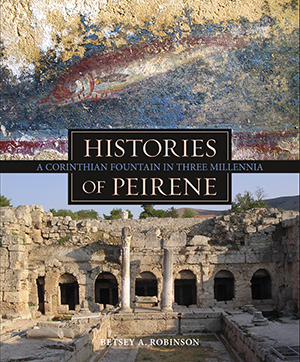Histories of Peirene: A Corinthian Fountain in Three Millennia

by Betsey A. Robinson
Ancient Art and Architecture in Context 2
418 pp, 218 col and b/w photos and ills, 18 col pls, 4 plans, 1 foldout
9.5" x 11.5"
Cloth, ISBN: 978-0-87661-965-0
Publication Date: July 2011
Status: Active
Retail Price $75
BUY PRINT
VIEW ONLINE
The Peirene Fountain as described by its first excavator, Rufus B. Richardson, is “the most famous fountain of Greece.” Here is a retrospective of a wellspring of Western civilization, distinguished by its long history, service to a great ancient city, and early identification as the site where Pegasus landed and was tamed by the hero Bellerophon. Spanning three millennia and touching a fourth, Peirene developed from a nameless spring to a renowned source of inspiration, from a busy landmark in Classical Corinth to a quiet churchyard and cemetery in the Byzantine era, and finally from free-flowing Ottoman fountains back to the streams of the source within a living ruin. These histories of Peirene as a spring and as a fountain, and of its watery imagery, form a rich cultural narrative whose interrelations and meanings are best appreciated when studied together. The author deftly describes the evolution of the Fountain of Peirene framed against the underlying landscape and its ancient, medieval, and modern settlement, viewed from the perspective of Corinthian culture and spheres of interaction. Published with the assistance of the Getty Foundation.
Winner of the 2011 Prose Award for Professional and Scholarly Excellence in the category of Archaeology/Anthropology. The Prose Awards are given annually by the Professional and Scholarly Publishing division of the American Association of Publishers.
About the Author: Betsey A. Robinson is Associate Professor of History of Art at Vanderbilt University.
Reviews:
"Robinson expertly displays her art historical and scientific expertise in this outstanding account of a worthy monument." L. J. Roccos, Choice (2012)
"The peculiarity and interest of the book resides in the oscillation between a traditional, very accurate archaeological report and a rich, almost novel-like historiographic inquiry. Robinson not only reviews Hill's canonical architectural and chronological framework, she also expands our views through a wide-ranging contextual approach that investigates the artistic, architectural, political, religious, geographic, geological, and even biological dimensions of Peirene." Julian Richard, AJA 118.3 (2014)
